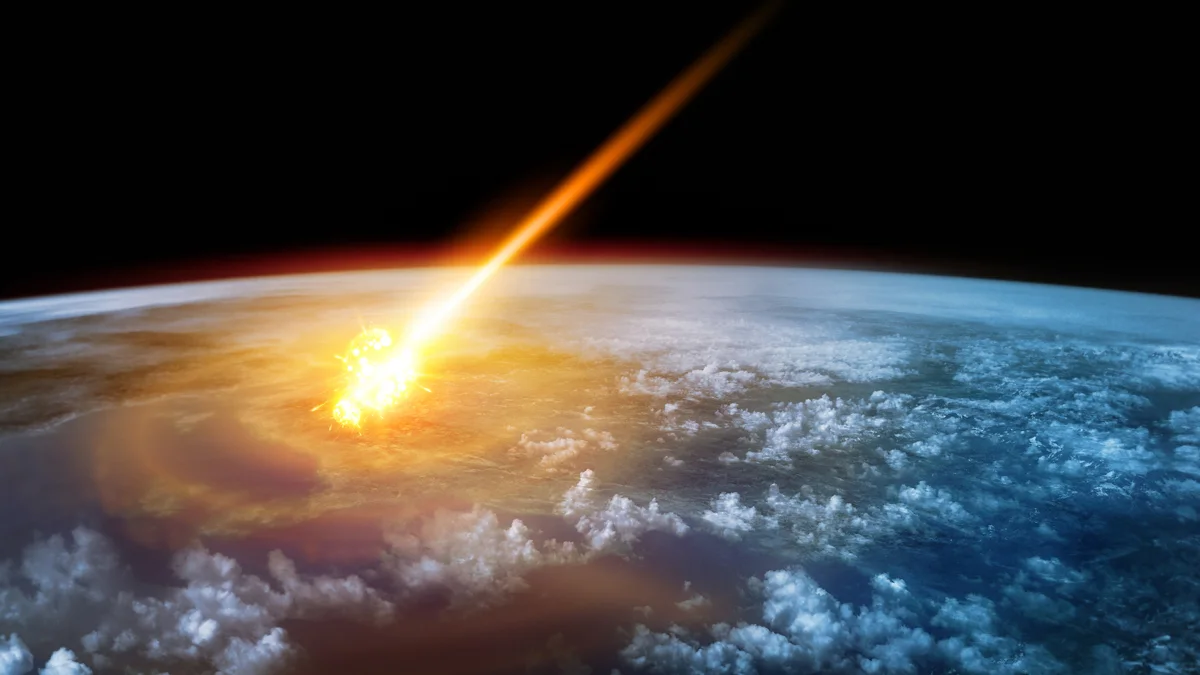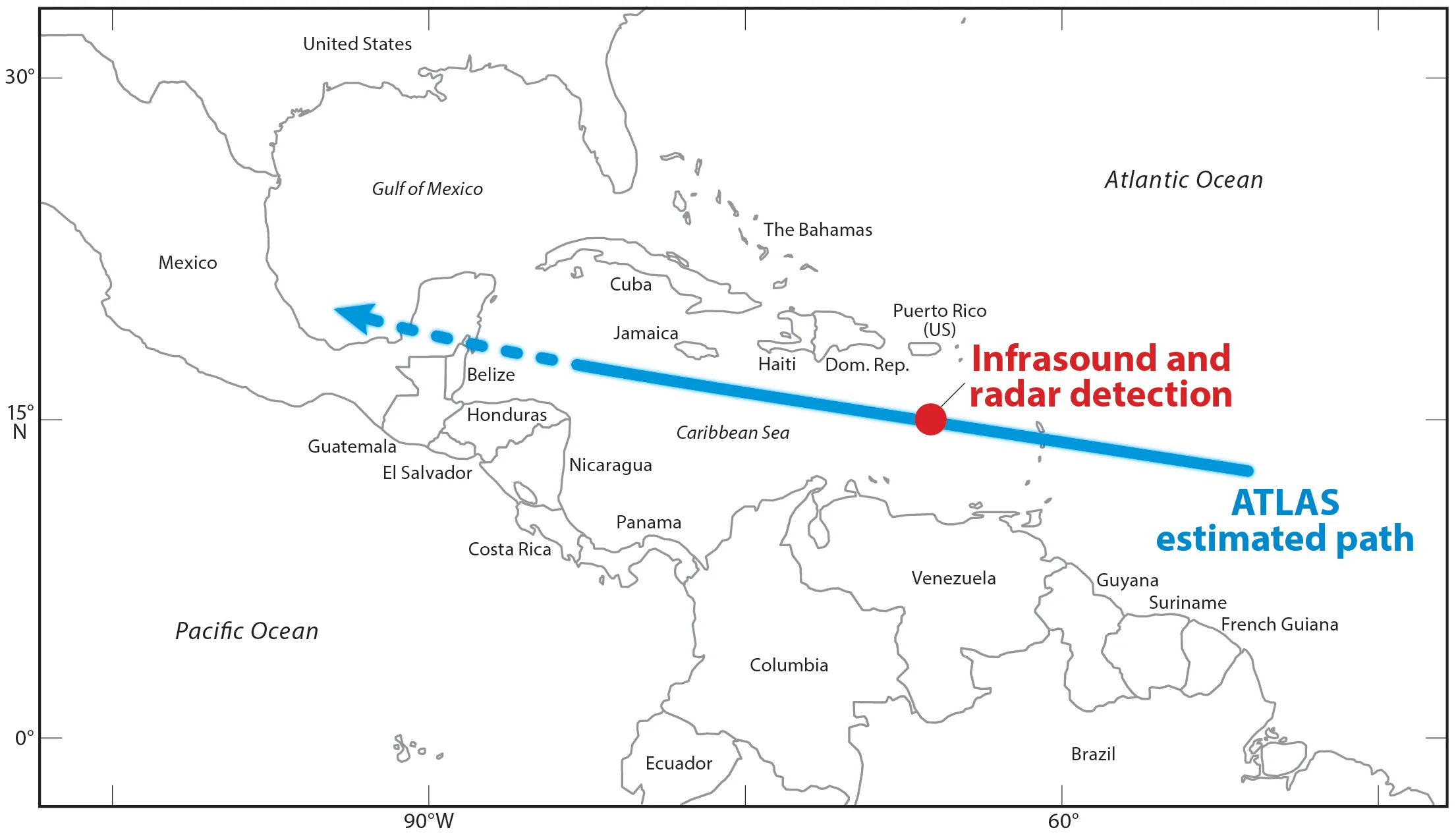
Powerful asteroid explosion spotted from space. See it here!
A large space rock was seen exploding over the Caribbean Sea
The newest generation of weather satellites are revealing our planet as we've never seen it before. One area of advancement comes in a somewhat unexpected arena, though - asteroid detection.
Early in the morning on Sunday, June 22, telescopes observing space from high atop two of Hawai'i's tallest peaks spotted a small asteroid - a space rock estimated at 4 metres wide, or roughly the size of a compact car - out beyond the orbit of the Moon.
Designated as '2019 MO', this was an otherwise unremarkable space boulder, except for one important thing. The trajectory plotted by astronomers showed it to be on a direct collision course with Earth!
Roughly 12 hours later the network of infrasound detectors run by the Comprehensive Nuclear Test Ban Treaty Organization picked something up.
According to the University of Hawai'i, "The Nexrad weather radar in San Juan, Puerto Rico also detected 2019 MO as it burnt up in the atmosphere, and pinpointed the entry location over the ocean, about 380 km south of San Juan, closely corresponding to the infrasound location."

A map of the predicted trajectory and final impact location for asteroid 2019MO. The predicted path is based on observations from the University of Hawaiʻi's ATLAS and Pan-STARRS survey telescopes. Credit: Larry Denneau (IfA/ATLAS), Brooks Bays (SOEST)
SPOTTED FROM SPACE!
It wasn't just Earth-based sensors that picked up this event, though. It was also seen from space, by the GOES-16 geosynchronous weather satellite.
Not only did the satellite's Geostationary Lightning Mapper detect the flash from the abrupt explosion of this asteroid, but it caught something extra. Watch closely in the animation above and you can also spot the condensation trail left behind by the fragments of the asteroid after it exploded.
In the zoomed-in animation below, these trails can be seen in the water vapour imagery. It also appears to show multiple trails from fragments of the asteroid plunging towards the surface.
Although it isn't easy to orient a three-dimensional track in two-dimensions, these trails would be angled downward and to the left, rather than straight towards the lower left or the view.
This isn't the first time that an asteroid has been detected just before it impacted. Astronomers had spotted three others before now - 2008 TC3 which exploded over northern Sudan, 2014 AA which impacted over the tropical Atlantic Ocean, and 2018 LA which broke up over northern South Africa. All, including this fourth one, 2019 MO, impacted harmlessly.
It is also not the first asteroid impact spotted by satellites. Japan's Himawari-8 weather satellite spotted the December 18, 2018 impact over the Bering Sea. NOAA's GOES-16 saw the February 1, 2019 meteoroid explosion over western Cuba.
This could be the first asteroid ever caught by GOES-16's lightning detector, however, and it may be the very first where we have been able to see the trails left behind as pieces of the asteroid plummeted towards the surface.
IS THERE A DANGER?
We have been fairly lucky so far, as a civilization. The 1908 Tunguska Event occurred far from large populations. The 2013 Chelyabinsk asteroid explosion happened over a city, but it was high enough in the air that it only shattered windows and caused minor injuries. There is a danger from asteroid impacts, however, which is why the ATLAS and Pan-STARRS survey telescopes (which detected 2019 MO) are constantly scanning the night skies for these objects.
Just recently, scientists with the University of Western Ontario determined that whatever object caused the Tunguska Event may be associated with a seldom seen daytime meteor shower, known as the Beta Taurids. If so, it could be that there is a swarm of large asteroids orbiting the Sun, which periodically swings by Earth, sometimes farther away and sometimes maybe just a bit too close for comfort. This year, likely one of the 'farther away' passes for this theoretical swarm, the Western U team is using telescopes to determine if this swarm actually exists. If it does, it could pose a threat to us on two different passes, in 2032 and 2036.
The timing is just about right for the Beta Taurids meteor shower, which reaches peak activity on June 28-29, so was this part of that asteroid swarm? Apparently not.
"Based on a preliminary orbit for the fireball, it does not appear to be part of the Taurid swarm," Paul Weigert, of the University of Western Ontario, told Spaceweather.com. "Its orbit is typical of near-Earth asteroids which have escaped from the asteroid belt."
Sources: University of Hawai'i | Spaceweather.com | Peter Brown | Frankie Lucena | Ernesto Guido
